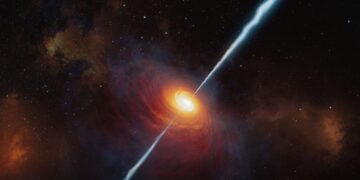A cosmic catastrophe is slowly unfolding in deep space, and astronomers have uncovered something astonishing—a supermassive black hole within the Large Magellanic Cloud (LMC) is heading straight for the Milky Way. While this event is billions of years in the making, its discovery reshapes our understanding of galactic evolution, black hole growth, and the future of our home galaxy.
How Was This Black Hole Found?
Astronomers didn’t see this black hole directly—because black holes do not emit light, they are invisible unless they are actively pulling in matter. Instead, they used a technique known as stellar motion tracking.
Using data from the European Space Agency’s Gaia mission, researchers studied the movements of hypervelocity stars—stars moving much faster than the surrounding ones. Some of these fast-moving stars seemed to have been ejected from the LMC, hinting at a powerful gravitational force. Further analysis led to the calculation of an unseen mass—around 600,000 times the mass of the Sun—suggesting the presence of a supermassive black hole.
The Timeline of an Epic Collision
While this sounds apocalyptic, there’s no immediate danger. The Large Magellanic Cloud is currently 160,000 light-years away and moving toward the Milky Way. According to simulations, the collision will happen in approximately 2 billion years. However, when it does occur, it will set off a dramatic chain reaction of cosmic events.
Impact on the Milky Way’s Structure
- The gravitational disruption will distort the Milky Way’s spiral arms, possibly creating new star formation regions.
- The LMC’s black hole will be pulled toward the center of the Milky Way, where it will merge with Sagittarius A*, the Milky Way’s own 4.3 million solar mass black hole.
- The merger of these two massive black holes could produce an enormous burst of gravitational waves, rippling across the universe.
What About the Solar System?
For now, our Solar System is relatively safe from this galactic mayhem. However, the gravitational turbulence could push stars out of their usual paths, possibly altering the structure of our local stellar neighborhood. If extreme, it could even shift the Sun’s position within the galaxy.
How Do Black Holes Grow?
Black holes don’t just appear fully formed—they grow by merging with other black holes and consuming gas and stars. Most galaxies, including the Milky Way, have a supermassive black hole at their core. However, how these black holes become so massive remains one of astronomy’s biggest questions.
The Role of Intermediate-Mass Black Holes
The 600,000 solar mass black hole in the LMC falls into the category of an intermediate-mass black hole (IMBH)—which is a missing link between stellar-mass black holes (a few times the Sun’s mass) and supermassive black holes (millions to billions of solar masses). These IMBHs are extremely rare, and confirming its existence helps astronomers understand how supermassive black holes form over cosmic timescales.
Why This Discovery Changes Our Understanding of the Universe
1. Proves That Black Holes Grow Through Galactic Mergers
One long-standing question in astrophysics is how black holes become so enormous. This event confirms that galactic collisions contribute significantly to black hole growth, as smaller black holes merge to form larger ones.
2. Provides a New Method for Detecting Hidden Black Holes
Since black holes can’t be directly observed, this discovery highlights a new way to find them—by studying how they affect nearby stars. Tracking hypervelocity stars could become a key method in hunting down hidden black holes across the universe.
3. Gives a Glimpse of the Milky Way’s Future
While we often think of galaxies as stable, this discovery reminds us that the universe is constantly changing. Our galaxy is not an isolated island—it will merge, evolve, and be reshaped by cosmic forces over billions of years.
What Comes Next?
Astronomers are now focused on confirming the black hole’s existence by:
- Conducting more precise velocity measurements of LMC stars.
- Using gravitational wave observatories to detect the eventual black hole merger.
- Observing other satellite galaxies to see if they also host intermediate-mass black holes.
The next-generation telescopes, including the James Webb Space Telescope (JWST) and the Extremely Large Telescope (ELT), will help astronomers study this black hole more closely.
Conclusion: A Cosmic Collision That Will Reshape the Milky Way
The discovery of a supermassive black hole on a collision course with the Milky Way is a game-changer for our understanding of galaxy evolution and black hole formation. While the collision itself is billions of years away, it reinforces the dynamic nature of our universe, reminding us that even our home galaxy is not permanent but a constantly evolving entity.
Reference:
Hypervelocity Stars Trace a Supermassive Black Hole in the Large Magellanic Cloud



















